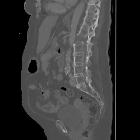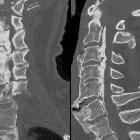Wirbelsäulenfrakturen bei Morbus Bechterew












Wirbelsäulenfrakturen bei Morbus Bechterew
Chalk-Stick-Fraktur Radiopaedia • CC-by-nc-sa 3.0 • de
Chalk stick, also known as carrot stick fractures, are fractures of the fused spine, classically seen in ankylosing spondylitis.
Terminology
Some authors define the chalk stick fracture as a fracture through a Pagetoid long bone (see Paget disease) .
Pathology
They usually occur through the disco-vertebral junction in the lower cervical or upper thoracic spine.
When several contiguous segments of the spine are fused, the fused column acts as a lever arm. This places greater than normal stresses on the spine. These fractures often occur following minimal trauma due to the altered biomechanics of the spine.
Etiology
Chalk stick fractures are most commonly encountered in ankylosing spondylitis but may also been seen in the fused spines in patients with :
- diffuse idiopathic skeletal hyperostosis
- ossification of the ligamentum flavum
- ossification of the posterior longitudinal ligament
- surgical spinal fusion
Treatment and prognosis
Non surgical management in an orthotic maybe suitable for patients with stable fracture patterns and no neurological defects. It should be noted that patients managed non operatively need aggressive follow up to ensure the fracture is adequately aligned till union is achieved and patient compliance with treatment .
Long term follow up is also necessary to ensure they do not develop worsening kyphotic deformity. If these patients do develop malalignment syndromes surgical management is recommended .
Patients with any neurological deficit or unstable fracture patterns need surgical fixation to decompress the spinal cord and stabilize the fracture. In cervical fractures a Halo Brace can also be considered to manage these patients .
History and etymology
Not surprisingly, it is named because of the resemblance of the fracture to breaking a chalk stick or a carrot.
Siehe auch:
- Morbus Bechterew
- Frakturen der Wirbelsäule
- Diffuse idiopathische Skeletthyperostose
- Chalk-Stick-Fraktur
- Chalk-Stick-Fraktur der HWS
und weiter:

 Assoziationen und Differentialdiagnosen zu Wirbelsäulenfrakturen bei Morbus Bechterew:
Assoziationen und Differentialdiagnosen zu Wirbelsäulenfrakturen bei Morbus Bechterew:



